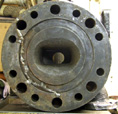
November 2007
Sometimes It could be better not to work
at the locomotives but to provide better conditions for work.
There are 50m track near the own house in the open air, thus it
was only possible to work on the machines in good weather and
in the warmer season. Therefore already for a long time the idea
of a small locomotive shed existed. During the last months this
shop has been built widely by myself. A direct track connection
to the shed doesn't exist. It will be provided by flying track
and a "frog" (portable turntable). An oddity is the
fact, that the existing track lies under a corner of the shed,
that's removeable if required.
August 2007
Now the RL3 drove the first, longer
distance from own strength and without forcing, however there
were some "smaller" problems thereby: after some time
the copper seals at the injection nozzles did not withstand the
pressure and the Diesel atomised the environment. This could be
eliminated by a reduction of the injection pressure on 100atm,
in addition the engine runs substantially more cleanly. The other
problem is already more unpleasant: it's not possible to brake
the loco by the motor, thereby an increasing knocking noise is
to hear in the gearbox. There's waiting something work for the
winter time! But during the event "day of the monument"
at the beginning of September the locomotive run in Glossen!
July 2007
In the reconstruction process of the RL3
loco the difficult chapter of the axle repair obviously could
be finished now. After a measurement resulted that the angle between
the two front wheels was 94° it was clear that the locomotive
thereby could not drive properly. Unfortunately it was not possible
and it would have the danger of breaking the wheels to dismount
them by a hydraulic press from the axle. So it was to be needed
to bore the axle from both sites and to slit it too. Than a new
axle had to be manufactured. To provide future difficulties and
not to make the same error like O&K fitting keys were necessary
as anti-twist locking devices. The work was expertly made by the
Elbtalwerk
Heidenau. A first test run from own strength showed the correct
function of the loco, now some fine work is still to do. The engine
runs very calmly and evenly, but it produced an exhaust cloud
as a steam locomotive. Hopefully it will be reduced after some
operation hours. _
_ _
_ _
_ _
_
The
open RL1a did not have any oil pressure at the engine during the
last start. In addition it lost cooling water, without any puddle
under the locomotive. That let assume a leakage inside the engine.
When opening the oil drain valve at first approximately two litres
of cooling water ran out only once, which confirmed this suspicion.
During a closer investigation it was to see that the cooling water
found a way to the crank case from the zone of the push rods.
To reach the leaky it was necessary to slice the external part
of the cylinder barrel.
This procedure showed a large frost damage, which had been repaired
many years ago with epoxy resin. This stuff had now aged and become
brittle and could not seal the fractures any longer. It will not
be simple now to close the tear by welding.
 _
_ _
_
May 2007
 Unfortunately the axle of the RL3 did not
return yet again to their place in the locomotive. It was impossible
to dismount the wheels from the axle by a hydraulic press. So
it is necessary to bore the axle and to manufacture it new after
this. This work is finished in the meantime, when shrinking arose
however new difficulties, which are not yet solved.
Unfortunately the axle of the RL3 did not
return yet again to their place in the locomotive. It was impossible
to dismount the wheels from the axle by a hydraulic press. So
it is necessary to bore the axle and to manufacture it new after
this. This work is finished in the meantime, when shrinking arose
however new difficulties, which are not yet solved.
But the repair of the cylinder head of the L180 is in progress,
it was welded by a specialized firm. After a valve refused itself
to be dismounted, it was bored, so that at least the valve seat
could be saved. Further several threaded bores at the head must
be regenerated, a toilsome but inevitable task.